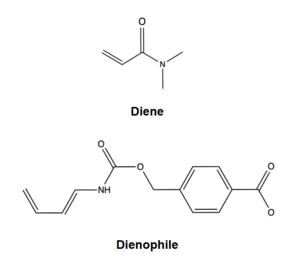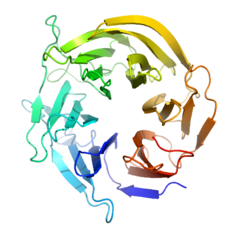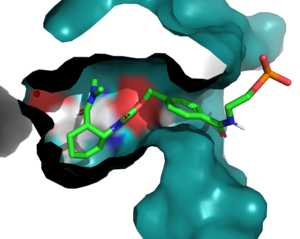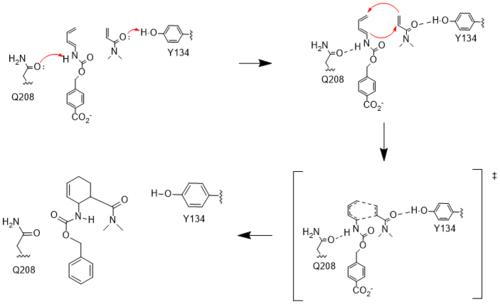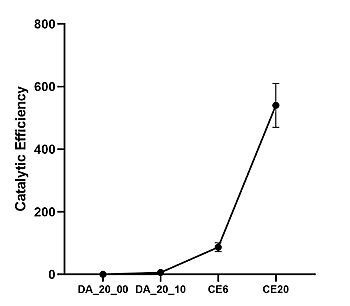Sandbox Reserved 1852
From Proteopedia
(Difference between revisions)
| Line 34: | Line 34: | ||
==Development and Evolution== | ==Development and Evolution== | ||
| + | ===DA_20_00=== | ||
| + | During initial computer modelling, over one million potential Diels-Alderase active sites could be matched to potential protein scaffolds.<ref name="Siegel"/> Computer optimization narrowed this down to 84 potential models, and researchers attempted to grow and purify those proteins within an E. coli host. Of the 50 proteins that were successfully purified, only 2 proteins proved to be sufficiently active after [https://en.wikipedia.org/wiki/Liquid_chromatography%E2%80%93mass_spectrometry LC-MS]screening. DA_20_00, which used a beta-propeller scaffold, had the most success in further mutations and therefore became the Diels-Alderase of choice.<ref name="Siegel"/> However, this initial enzyme's active site had very little catalytic activity, seen in its low catalytic efficiency after kinetic screening.<ref name="Siegel"/><ref name="Preiswerk"/> | ||
===DA_20_10=== | ===DA_20_10=== | ||
DA_20_10 provided key mutations in and around the active site that increased the hydrophobicity, provided structural stability, and increased interactions between the ligand and surrounding residues. | DA_20_10 provided key mutations in and around the active site that increased the hydrophobicity, provided structural stability, and increased interactions between the ligand and surrounding residues. | ||
=====Q162R===== | =====Q162R===== | ||
| - | :Residue 162, a <scene name='10/1075254/Q162/2'>glutamine</scene>, resides near the top of the binding entrance to the enzyme, and is outside 3 Angstroms in most models on the enzyme. It can act as a hydrogen bond donor to the terminal phosphate on the ligand when in proximity. To increase this interaction, the group chose to mutate this Q to an <scene name='10/1075254/Q_to_r/1'>arginine</scene>, which decreased the length of the potential hydrogen bond to within 2.5 Angstroms, increasing the strength of the interaction. | + | :Residue 162, a <scene name='10/1075254/Q162/2'>glutamine</scene>, resides near the top of the binding entrance to the enzyme, and is outside 3 Angstroms in most models on the enzyme. It can act as a hydrogen bond donor to the terminal phosphate on the ligand when in proximity. To increase this interaction, the group chose to mutate this Q to an <scene name='10/1075254/Q_to_r/1'>arginine</scene>, which decreased the length of the potential hydrogen bond to within 2.5 Angstroms, increasing the strength of the interaction.<ref name="Siegel"/> |
=====S284A===== | =====S284A===== | ||
| - | :Residue 284 resides deep within the binding pocket of the enzyme. The group chose a<scene name='10/1075253/S284/2'>serine</scene> to <scene name='10/1075253/A285_scence/2'>alanine</scene> mutation to increase the hydrophobicity of the binding pocket and reduce reactivity, without also changing any steric characteristics in the region ''unintentionally'' near the catalytic residues. | + | :Residue 284 resides deep within the binding pocket of the enzyme. The group chose a<scene name='10/1075253/S284/2'>serine</scene> to <scene name='10/1075253/A285_scence/2'>alanine</scene> mutation to increase the hydrophobicity of the binding pocket and reduce reactivity, without also changing any steric characteristics in the region ''unintentionally'' near the catalytic residues.<ref name="Siegel"/> |
=====A285N===== | =====A285N===== | ||
| - | :<scene name='10/1075254/N285/3'>N285</scene>, as follows, is also buried within the binding pocket. The group introduced this mutation to increase steric hindrance with the catalytic tyrosine, reducing the number of rotamers the residue has to increase the reactivity of the enzyme by lowering the distance between Y134 and the ligand. | + | :<scene name='10/1075254/N285/3'>N285</scene>, as follows, is also buried within the binding pocket. The group introduced this mutation to increase steric hindrance with the catalytic tyrosine, reducing the number of rotamers the residue has to increase the reactivity of the enzyme by lowering the distance between Y134 and the ligand.<ref name="Siegel"/> |
===CE6=== | ===CE6=== | ||
| - | The DA_20_10 model of the Diels Alderase was further enhanced by players of the online game "Foldit." Building on preliminary early data, players were asked to optimize various helical structures that would surround and support the ligand. After over 100,000 designs were tested, the top-scoring CE6 model was finalized, containing as <scene name='10/1075252/Alpha_helix_highlighted/4'>alpha helix cap</scene> that favorably constrains ligand orientation. This "cap" consists of two helices--helix one spans from residues 36-44, and helix two spans from residues 48-56. | + | The DA_20_10 model of the Diels Alderase was further enhanced by players of the online game "Foldit." Building on preliminary early data, players were asked to optimize various helical structures that would surround and support the ligand. After over 100,000 designs were tested, the top-scoring CE6 model was finalized, containing as <scene name='10/1075252/Alpha_helix_highlighted/4'>alpha helix cap</scene> that favorably constrains ligand orientation. This "cap" consists of two helices--helix one spans from residues 36-44, and helix two spans from residues 48-56.<ref name="Eiben"/> |
===CE20=== | ===CE20=== | ||
| - | In this generation, it was found that the most catalytically efficient models had mutated T34, P48, and R56 to <scene name='10/1075254/Ce_20_mutations/4'>I43,L48, and S56</scene>. These mutations further tightened the binding pocket and create a more hydrophobic environment. | + | In this generation, it was found that the most catalytically efficient models had mutated T34, P48, and R56 to <scene name='10/1075254/Ce_20_mutations/4'>I43,L48, and S56</scene>. These mutations further tightened the binding pocket and create a more hydrophobic environment.<ref name="Preiswerk"/> |
==Kinetics== | ==Kinetics== | ||
| - | [[Image:Diels_Alderase_kinetic_table_Large.jpeg| | + | [[Image:Diels_Alderase_kinetic_table_Large.jpeg|360px|left|thumb|Figure X. Catalytic efficiencies of key Diels-Alderase generations. Kinetic data was measured at 25 degrees Celsius, in PBS, at pH 7.4 <ref name="Preiswerk">PMID:24847076</ref>]][[Image:Diels-AlderaseKineticgraph.jpg|350px|right|thumb|Figure X. Improvement of catalytic efficiency <ref name="Preiswerk"/>]] |
| - | Classic [https://en.wikipedia.org/wiki/Michaelis%E2%80%93Menten_kinetics Michaelis-Menten kinetics]were determined for each generation of the enzyme. As the Diels-Alderase relies on a catalyzed interaction between both the diene and dienophile, a Michaelis binding constant was determined for each substrate separately before catalytic efficiency was calculated. The CE20 model of the enzyme is over 400-fold more efficient than the first enzyme model.<ref name="Preiswerk"/> | + | Classic [https://en.wikipedia.org/wiki/Michaelis%E2%80%93Menten_kinetics Michaelis-Menten kinetics]were determined for each generation of the enzyme. As the Diels-Alderase relies on a catalyzed interaction between both the diene and dienophile, a Michaelis binding constant (Km value) was determined for each substrate separately before catalytic efficiency was calculated. The CE20 model of the enzyme is over 400-fold more efficient than the first enzyme model due to increasing active site specificity.<ref name="Preiswerk"/> |
| - | ==Application== | ||
| - | The CE20 model is up to 300 fold more efficient than the first generation model, making it the most efficient Diels-Alderase yet. It surpasses many other biological (antibody) and artificial (ribozyme, metalloenzyme) attempts at catalyzing the Diels-Alder reaction. Even then, the CE20 model has a catalytic efficiency value at least 4 orders of magnitude lower than those seen in other moderately-efficient natural enzymes, demonstrating the innate slowness of the Diels-Alder reaction. | ||
| - | Though the rate of product formation using this enzyme is not significantly different from that found when reactants reflux free in solution, the | + | |
| + | |||
| + | |||
| + | |||
| + | ==Applications== | ||
| + | The CE20 model is up to 300 fold more efficient than the first generation model, making it the most efficient Diels-Alderase yet. It surpasses many other biological (antibody) and artificial (ribozyme, metalloenzyme) attempts at catalyzing the Diels-Alder reaction. Even then, the CE20 model has a catalytic efficiency value at least 4 orders of magnitude lower than those seen in other moderately-efficient natural enzymes, demonstrating the innate slowness of the Diels-Alder reaction.<ref name="Preiswerk"/> | ||
| + | |||
| + | Though the rate of product formation using this enzyme is not significantly different from that found when reactants reflux free in solution, the Diels-Alderase shows a vast improvement in product stereoselectivity. When refluxed in a room temperature aqueous solution containing the necessary substrates, the enzyme catalyzed an over 90% conversion rate, producing only the 3R,4S endo cyclohexane product isomer. By comparison, refluxing the substrates free in solution for a similar duration of time yields a racemic (66:34) mixture of endo and exo products. It is primarily for these stereoselective benefits that this enzyme is valuable for synthetic purposes. <ref name="Preiswerk"/> | ||
Future improvement of the Diels-Alderase will likely revolve around the improvement of catalytic efficiency, further constriction of the active site, and selective production of varying stereoisomers. | Future improvement of the Diels-Alderase will likely revolve around the improvement of catalytic efficiency, further constriction of the active site, and selective production of varying stereoisomers. | ||
Revision as of 01:46, 16 April 2025
| This Sandbox is Reserved from March 18 through September 1, 2025 for use in the course CH462 Biochemistry II taught by R. Jeremy Johnson and Mark Macbeth at the Butler University, Indianapolis, USA. This reservation includes Sandbox Reserved 1828 through Sandbox Reserved 1846. |
To get started:
More help: Help:Editing |
Diels-Alderase
| |||||||||||
